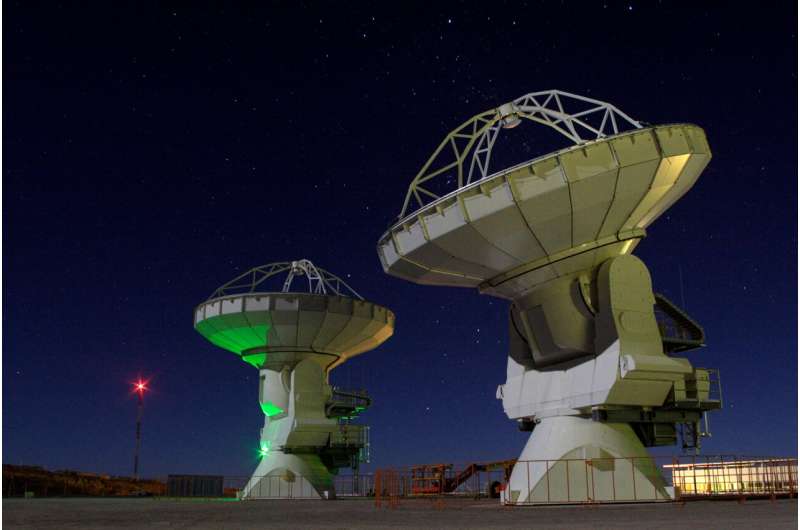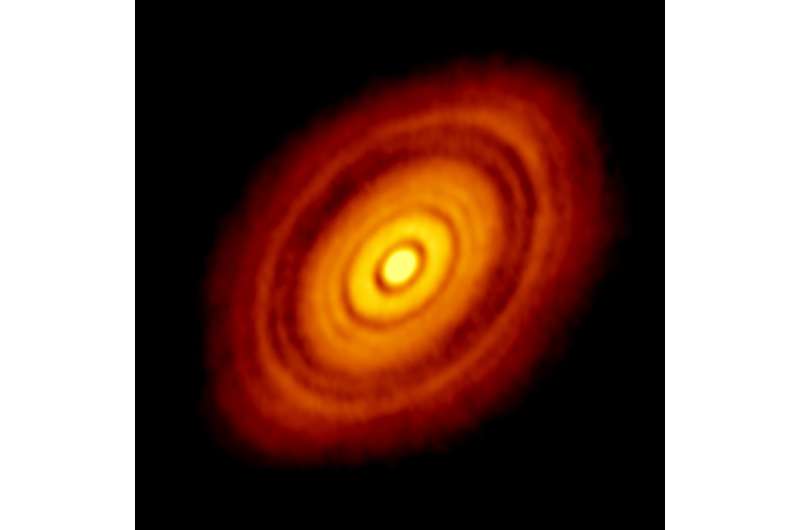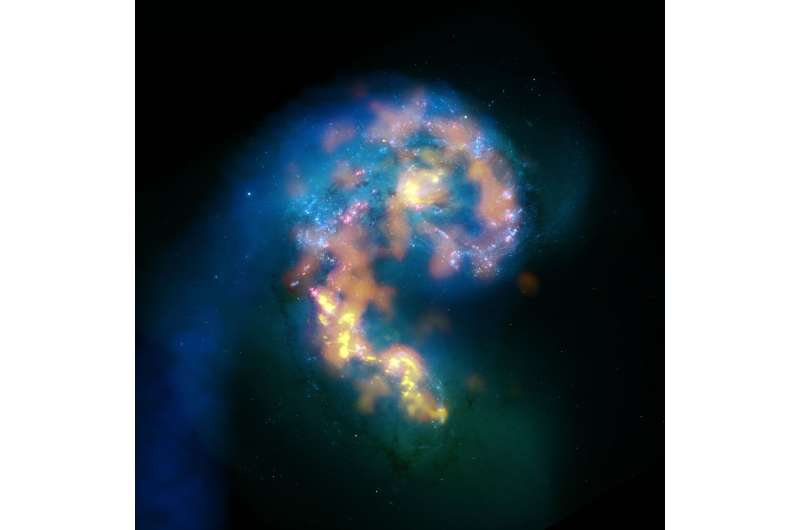Two North American 12-meters sit under the stars at the ALMA Operations Support Facility (OSF). Towards the left of the image in the distance is the Holography Tower. The antennas are able to receive a signal from this tower and use it to make a map of their surfaces. The individual panels that make up their surface can then be adjusted so that the surface is as close to being perfect parabola as possible. Credit: Carlos Padilla
On March 13th, 2023, astronomers around the world will mark the 10th anniversary of the inauguration of the Atacama Large Millimeter/submillimeter Array (ALMA), the world's largest radio telescope.
Over the past decade, the international ALMA collaboration—led by the U.S. National Science Foundation's National Radio Astronomy Observatory (NRAO), the European Southern Observatory (ESO), and the National Astronomical Observatory of Japan (NAOJ)— has revolutionized our understanding of the Universe and unveiled its secrets, from the formation of planets, stars, and galaxies to deciphering the chemistry of the cosmos, and even taking part in capturing the first images of black holes.
ALMA's decade of success was preceded by Early Science Observations in 2011, nearly a full two years before the telescope was inaugurated. This test period for ALMA yielded complex and beautiful images which revealed star formation and violent galaxy mergers in the Antennae Galaxies at a level of detail no other telescopes on Earth had ever attained. These pre-inaugural observations allowed ALMA to grow into what it is today.
"Since its first light, ALMA has not only changed our understanding of the Universe, but also the way in which we look at it," said Tony Beasley, Director of NRAO and AUI Vice President for radio astronomy.
"In order to look deeper into the Universe and to see things that no other telescopes can see with such clarity, like water hiding out in the disks of young stars, and the supermassive black hole in the heart of the Milky Way, we have continuously developed cutting-edge technology, including some of the fastest supercomputing processors in the world."
ALMA image of the young star HL Tau and its protoplanetary disk. This best image ever of planet formation reveals multiple rings and gaps that herald the presence of emerging planets as they sweep their orbits clear of dust and gas. Originally imaged in 2014 by ALMA scientists, this updated image brings further clarity to the developing environment around HL Tau. Credit: ALMA(ESO/NAOJ/NRAO); C. Brogan, B. Saxton (NRAO/AUI/NSF)
ALMA consists of 66 antennas, spread over up to 16 kilometers—nearly 10 miles—on the Chajnantor Plateau of the Chilean Andes at 5,000 meters—or 16,404 feet—above sea level. The technology that makes the telescope special is borne of an international collaboration of 21 countries from across North America, Europe, and East Asia. NRAO's Central Development Laboratory (CDL) is responsible for the development of the Band 6 receiver, ALMA's most scientifically productive receiver, which was approved for upgrades in 2021.
ALMA was also approved earlier this year for the development of a new central correlator and digital transmission system, upgrades that will eventually increase the system bandwidth by a factor of four, and that will be carried out by NRAO and several other partners. This technology, and other innovations like it, have supported ALMA-user scientists to produce more than 3,000 scientific publications to date. That's nearly one publication per day for a decade.
In this composite image of the merging cores of the Antennae Galaxies, optical (white and pink), radio (blue) and millimeter/submillimeter (orange and gold) overlay to show us the history and future of star formation. The optical image shows stars that are shining now. The radio shows gas that is probably too thin to become stars. And the mm/submm shows all the places where new stars will someday form. The Antennae Galaxies provided the first science images from ALMA in 2011 during early science observations. Credit: B. Saxton (NRAO/AUI/NSF) with data provided by ALMA (ESO/NAOJ/NAOJ) and NASA/ESA
"ALMA has captured the world's imagination since it unveiled its first images more than a decade ago, and it has opened new windows on the Universe that could not have been opened otherwise," said Karen Marrongelle, U.S. National Science Foundation Chief Operating Officer. "Our commitment to ALMA now and for the future is the same as it was then: to develop the technology that unlocks and expands our knowledge of the Milky Way and every other galaxy in our Universe."
Among ALMA's most notable contributions are the first clear pictures of planet formation, observed around the young star HL Tau by scientists from ALMA's partner regions and led by NRAO in 2014, and supermassive black holes M87* and SgrA*, observed by the Event Horizon Telescope (EHT) collaboration in 2019 and 2022, respectively.
"ALMA has transformed our understanding of the Universe and opened new research frontiers," said Sean Dougherty, Director of ALMA. "We are very proud of the accomplishments of the past decade and excited about the discoveries over the next ten years."
Provided by National Science Foundation


























